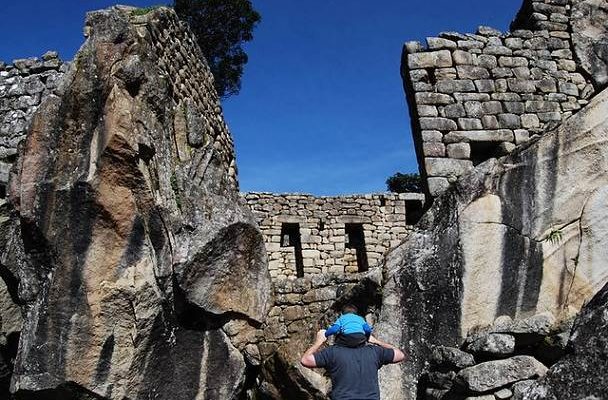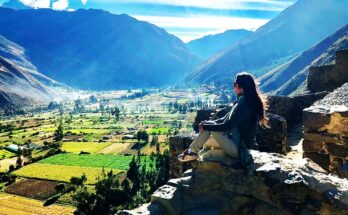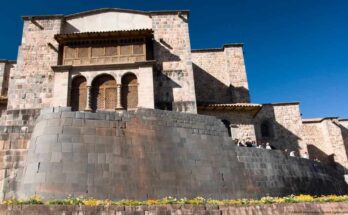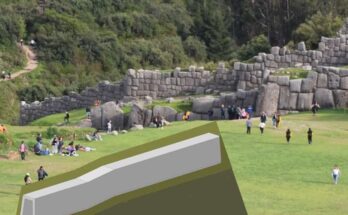Peru can be split into four major regions for most tourists: Andean Highlands, Amazon Basin, Desert Coast and the Northern Highlands.
In the Andean Highlands the number one draw for tourists is visiting Machu Picchu and hiking the Inca Trail into the famous Incan ruins. Along with a Machu Picchu stop, most people stop in the stunning Sacred Valley and historic Cusco. Travelers also frequent Lake Titicaca, the world’s highest navigable lake dotted with islands inhabited since pre-Incan times. Arequipa and the Colca Canyon, the second deepest canyon in the world, are two recommended destinations as well. Of course, one of the best reasons to visit the Andes is to trek some of the highest and most scenic trails in the world (please see below for more information on recommended Peru treks).
The Amazon basin has three major areas accessible by tourists: Tambopata National Park; Manu National Park; and Iquitos. Visitors to Tambopata and Manu stay in rustic, but comfortable lodges, exploring the rainforest by nature walks, canopy tours, and small boat rides. Iquitos is the jumping off point for cruises along the Amazon River wherein passengers overnight on the boat. If you’re really interested in wildlife, Tambopata and Manu are the destinations for you. Tambopata is more popular and easier to visit than Manu; however, Manu boasts the greatest biodiversity and wildlife abundance of anywhere in the Amazon Basin.
The desert coast is perfect for archeology buffs, surfing enthusiasts, and those wanting to get off the beaten path. Here you can fly over the intriguing Nazca lines, explore vast pre-Incan ruins, and relax in the laid-back beach towns dotting the northern coast. After viewing the Nazca lines, it’s worthwhile to visit the Reserva Nacional Paracas, which is a stretch of protected coastline that is home to sea lions, penguins, and over two hundred bird species. Traveling north along the coast, you can visit the Chan Chan ruins, Old Trujillo and the Huaca Luna pyramid before hitting the surf.
The Northern Highlands contains some of the most fascinating Incan trails and ruins outside of the Sacred Valley in the South. In the picturesque Cajamarca area alpine grasslands, ancient stone canals and isolated Andean villages are highlights on the Qhapaq Ñan (or Inca Highway) treks. On the other side of the tropical Marañon Canyon, the Andes rise over 10,000 ft offering an impressive change of scenery. The nearby Chachapoya region features the impressive Kuelap ruins whose architecture feats and historic importance rival that of the more famous Machu Picchu.
GETTING TO PERU
Most people fly into Lima, which is the capital and largest city in Peru. From there, you can catch flights or buses to other destinations in the country. There are also international flights into Arequipa, a picturesque city that is a jumping off point to the Colca Canyon. If you have more time on your hands, you can travel by bus into Peru. From Bolivia, many people cross the Peruvian border by traveling along the shore of Lake Titicaca. Adventurous travelers can take a bus from Chile through the Atacama Desert to arrive in Southern Peru or from Ecuador to arrive in Northern Peru.
MACHU PICCHU
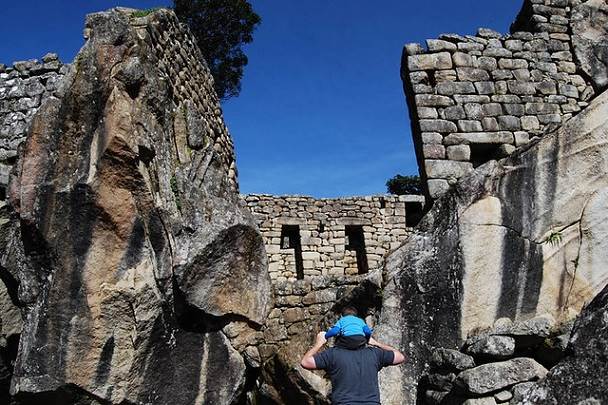
Often called the “Lost City of the Incas”, Machu Picchu is a well-preserved pre-Columbian Inca ruin site located on a high mountain ridge in Peru about 44 miles (70 km) northwest of Cusco. Forgotten for centuries by the outside world, although not by locals, it was brought back to international attention by Yale archaeologist Hiram Bingham who rediscovered it in 1911, and wrote a best-selling work about it. Machu Picchu is probably the most familiar symbol of the Inca Empire. Since 1983 the site has been designated as a UNESCO World Heritage Site, and has been the subject of concern about damage caused by tourism.
To visit Machu Picchu, you can either hike the Inca Trail into the site (see above) or you’ll have to take the train to Aguas Calientes and then a short bus ride to Machu Picchu. The train service offers a spectacular journey in the Andes region and is a little over 3-hours (one-way). Once in Machu Picchu, you can easily spend a day wandering the ruins and taking a guided tour. Many people spend a night in Aguas Calientes so they can head up to Machu Picchu for the sunrise and a less crowded experience at the site. At the end of your tour, you can take the afternoon train back to Ollantaytambo or Cusco.
WEATHER & WHEN TO VISIT
The busiest tourist season in Peru is during the South American winter (June through August), which is also the dry season. The temperatures are pleasant and the climate is drier in the Andes and the Amazon during this time. Keep in mind that in the Andes and Amazon, there is always a good chance for rain and sun each day, no matter what the season.
The wet season lasts from December to April, creating overcast skies and muddy trekking. It’s certainly still possible to visit both the Andes and Amazon during this time, though some trips won’t be available. In order to avoid both the crowds and rainy weather, traveling during the shoulder seasons (May, September, October and early November) is your best bet. These wet and dry seasons are flipped on the desert coast.
Another consideration is the hugely popular Inti Raymi festival in June when tourists flock to Cusco to witness the weeklong celebration. While it’s a worthwhile event to see, if you’re planning a last-minute trip or trying to save some cash, this is not the time to visit Cusco.
CUSCO’S WEATHER
The weather in the Andean highland city of Cusco can be influenced by great masses of air coming in from the rainforest, the Andes and occasionally from Patagonia. The air from the Amazon is quite humid; the air from the Peruvian or Bolivian Andes is cold and dry.
The average daytime highs range from 66 F in the dry season (May to September) to 69 F in the rainy season (October to April). The average lows range from 32 F in the dry season to 43 F in the rainy season. October is the average warmest month and on average, the coolest month is June. The maximum average precipitation occurs in January.
RECOMMENDED TREKS
The most famous trek, the Inca Trail to Machu Picchu, has a well-deserved reputation for being a challenging and fascinating trek. The hike usually takes 4 days, but there are also 2, 5, and 9-day versions of the trek. The classic Inca Trail is the only way to enter Machu Picchu by foot and it has become very popular for that reason. The Peruvian government has put into place a permit system to limit the number of travelers on the trail and ensure responsible travel practices. If you don’t secure your permit well months in advance, there’s very little chance of getting one so plan accordingly.
However, the Inca Trail is certainly not the only option for avid hikers. If you still want to hike to Machu Picchu, the Apu Salkantay and Lares Valley hikes are popular options. If you’re in good shape, then we highly recommend the trek to Choquequirao (or “Machu Picchu’s sacred sister”). This site can only be reached by following an ancient Incan path and the trek is considered the hidden gem of the area.
If you want to get away from the crowds in Cusco, you can easily find some challenging and scenic treks, many of which are considered far superior to the Inca Trail. Not too far from Cusco, you can begin the 7-day Ausangate trek through the stunning Cordillera Vilcanota. This challenging trek circles the towering Ausangate massif, passing glacial lakes and Andean Villages along the way. Huarez is the jump-off point to several treks in the Cordillera Blanca, whose numerous glacier-graced peaks are reminiscent of the Himalayas. Notable peaks in the area include Huascaran (the second highest peak in South America) and the Alpamayo peak, considered one of the most beautiful in the world.
THE CLASSIC INCA TRAIL TO MACHU PICCHU
The Inca Trail was the Royal Highway that led pilgrims and officials
of the Empire to the Sacred City of the Incas. Although there are
thousands of mile of Inca Trail system, or Qhapaq Ñan,
in South America, the trail known as “The Inca Trail” between
Ollantaytambo and Machu Picchu is the only way to reach the famous ruins
on foot. For most people, the trail begins at Km 88 (as measured by the
railway between Cusco and Machu Picchu) and ends at Machu Picchu
itself. The Inca Trail is Peru’s most well known hike, combining a
stunning mix of Inca ruins, mountain scenery, lush cloud forest and rich
subtropical jungle. Although it’s become the classic and most
recognized Inca trail, there is fabulous trekking on other Inca Trails
in Peru, and these trips are less crowded and are not regulated by the
Government of Peru, meaning no permit is required to trek there.
SACRED VALLEY & CUSCO HIGHLIGHTS
The Sacred Valley, also known as the Urubamba Valley, is named for the sparkling Urubamba river that flows at its base. The valley basically encompasses both everything between Ollantaytambo and Pisaq, northwest of Cusco. It was an important area for the Incas, especially due to the pleasant climate, fertile soil and spectacular mountain views. Several Incan ruins dot the landscape as well as traditional Andean villages whose inhabitants’ way of life has changed little in the last centuries.
Not far south of the Sacred Valley lies Cusco, which was the center of the Inca dynasty. It was called, “the bellybutton of the world” and today you can still see the patchwork of cultural impressions left on the city. Cusco shows off an eclectic mixture of Inca stonework walls, Spanish Colonial churches and narrow cobblestone roads climbing the steep hills. Many streets bear Quechua names and the llamas are as much used for photo opps as practical livestock. While the city teems with tourists, most leave wishing they had spent more time in this fascinating place where you can spend days wandering its lovely passageways. The ruins of Sacysayhuaman overlooking Cusco are easily accessed by short taxi ride or challenging walk through steep neighborhoods. Made of gigantic carved boulders, the fortress is an impressive testament to both Incan masonry and military fortitude.
Most tourists spend just a day in Cusco and a day in the Sacred Valley (usually in Ollantaytambo or Pisaq) before rushing up to Machu Picchu. While each of these destinations is fascinating to visit, it’s worth it to step off the tourist trail a bit. Pisaq hosts the most popular indigenous market in the area and above the town you’ll find some of the most well preserved Incan ruins. Other indigenous markets in the Sacred Valley happen in the Chincheros, Willoq and Patanchanca villages. Likewise, Ollantaytambo is a great stop to stroll around the charming, if tourist-packed, town and visit the nearby Incan fortress of the same name. Other Incan sites worth seeing are Urubamba and Maras/Moray with its lovely, ancient saltpans.
ALTITUDE SICKNESS
Peru is famous for it’s impressive altitude; many of its most popular destinations sit at 8,000 feet above sea level. Cusco, the hub for many treks including the Classic Inca Trail, is 11,600 ft above sea level. Altitude sickness can begin to affect people at 6,500 feet above sea level. Symptoms will usually manifest after 6-10 hours of arrival and can take a day or two to subside. The symptoms include a headache first, then you may experience a lack of appetite, nausea, or vomiting; fatigue; dizziness; light-headedness; and/or insomnia. Other symptoms include shortness of breath, rapid pulse, drowsiness, and swelling of the face, hands, or feet. Extreme altitude sickness can result in swelling of the brain and fluid accumulation in the lungs, which can be fatal. Keep in mind that these are extreme cases and not commonplace. The vast majority of folks feel lousy or suffer a headache for the first day or two at high altitude. Please refer to the section “What can I do about altitude sickness” for more information:
https://www.apec2016.pe/treatment-for-altitude-sickness/
PERUVIAN RAINFOREST RECOMMENDATIONS
Peru is considered one of the best places to experience the fascinating biodiversity and ancient cultures within the Amazon Rainforest. However, the rainforest covers more than half of the country, so it can be tricky to know where to begin your journey. Here are some of the top destinations within the Peruvian Rainforest:
TAMBOPATA NATIONAL PARK
The Tambopata National Park showcases the classic Peruvian rainforest. Upon arrival, one will appreciate the enormous biodiversity and the habitats of each of the ecosystems, which represent native flora and fauna with 165 species and 41 families of trees, 103 species of mammals, 1300 species of butterflies and 90 species of amphibians. It is home to one of the world’s largest parrot and macaw claylicks, and the gathering of these birds is one of the world’s great wildlife spectacles. Recommended trip: Tambopata Research Center (5 days)
MANU NATIONAL PARK
Manu is considered the best wildlife viewing location in the upper Amazon basin. Expect to be “roughing it” a bit more than in Iquitos or Tambopata; but for wildlife buffs, this is a small trade-off. Manu boasts the highest bird, mammal, and plant diversity of any park on Earth, including 1,000 of the world’s 9,700 bird species, 200 species of mammals, and 15,000 species of flowering plants. The most photogenic spectacles are frolicking Giant Otters, 1,000 parrots and macaws at a riverbank clay lick, dancing Cocks-of-the-Rock, habituated monkeys, and huge Lowland Tapirs at a forest clay lick. Recommended trip: Manu Wildlife Center (5 Days),
IQUITOS
A cruise down the Amazon, beginning in Iquitos, is the most popular (and therefore most crowded) way to explore the Peruvian Rainforest. The Pacaya Samiria Reserve spans more than five million acres, making it twice the size of Yellowstone Park—and it is rich with wildlife and aquatic life. Only about 30,000 people live on the vast tract of land within the Pacaya Samiria area and you will have the chance to meet some of the local people as part of your Amazon cruise experience. In addition, Pacaya Samiria park rangers will show you some of the conservation and sustainability projects that are part of this vast reserve within the Amazon rain forest. Recommended trip: Luxury Amazon Voyage on the M/V Aqua
OTHER PERU ADVENTURES
Peru is more than just the Inca Trail and we think you should break out of the rut to really experience this incredible country. Here are some of the adventures we think get overlooked, but shouldn’t!
– Stand-up paddle Lake Titicaca and overnight with a local family on one of the islands.
– Whitewater raft the Cotahuasi or the Apurimac river – amazing off-the-beaten path rivers that get you deep into the Peruvian wilderness.
– Bike the Altiplano from Lake Titicaca to Cusco (stopping to see Machu Picchu afterwards of course).
– Discover the mysterious and expansive pre-Inca ruins of the North
– Hike down the Colca Canyon and soak in hot springs.
– Tear around the Lares’ Valley and Sacred Valley’s incredible singletrack and camp by natural hotsprings.
– Raft from the altiplano down the Tambopata River through the most remote and untouched rainforest in the Amazon.
